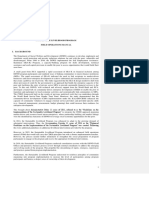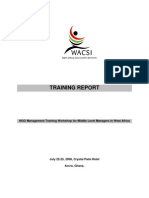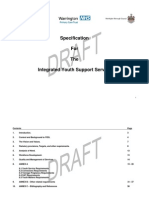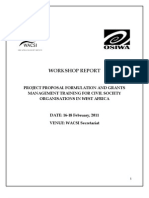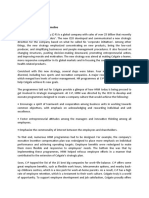0 ratings0% found this document useful (0 votes)
A Strategic Plan For Namibia Youth Credit Scheme - Aune
A Strategic Plan For Namibia Youth Credit Scheme - Aune
Uploaded by
Ishmael Mc Gazza MubwandarikwaThe document outlines a strategic plan for transforming the Namibia Youth Credit Scheme (NYCS) employment program into an independent institution. Currently, NYCS operates under the Ministry of Youth but lacks a legal mandate. The plan calls for establishing NYCS as an autonomous organization with powers to develop its own strategies, policies, structures and recruit staff. This would allow NYCS to better serve Namibian youth by providing loans, business training and counseling to support entrepreneurship and employment. Establishing NYCS as an independent institution with a secure funding source is presented as key to ensuring its long-term sustainability and ability to meet the needs of Namibian youth.
Copyright:
© All Rights Reserved
Available Formats
Download as DOCX, PDF, TXT or read online from Scribd
Download as docx, pdf, or txt
A Strategic Plan For Namibia Youth Credit Scheme - Aune
A Strategic Plan For Namibia Youth Credit Scheme - Aune
Uploaded by
Ishmael Mc Gazza Mubwandarikwa0 ratings0% found this document useful (0 votes)
The document outlines a strategic plan for transforming the Namibia Youth Credit Scheme (NYCS) employment program into an independent institution. Currently, NYCS operates under the Ministry of Youth but lacks a legal mandate. The plan calls for establishing NYCS as an autonomous organization with powers to develop its own strategies, policies, structures and recruit staff. This would allow NYCS to better serve Namibian youth by providing loans, business training and counseling to support entrepreneurship and employment. Establishing NYCS as an independent institution with a secure funding source is presented as key to ensuring its long-term sustainability and ability to meet the needs of Namibian youth.
Original Description:
Strategic Planning
Original Title
A Strategic Plan for Namibia Youth Credit Scheme - Aune
Copyright
© © All Rights Reserved
Available Formats
DOCX, PDF, TXT or read online from Scribd
Share this document
Did you find this document useful?
Is this content inappropriate?
The document outlines a strategic plan for transforming the Namibia Youth Credit Scheme (NYCS) employment program into an independent institution. Currently, NYCS operates under the Ministry of Youth but lacks a legal mandate. The plan calls for establishing NYCS as an autonomous organization with powers to develop its own strategies, policies, structures and recruit staff. This would allow NYCS to better serve Namibian youth by providing loans, business training and counseling to support entrepreneurship and employment. Establishing NYCS as an independent institution with a secure funding source is presented as key to ensuring its long-term sustainability and ability to meet the needs of Namibian youth.
Copyright:
© All Rights Reserved
Available Formats
Download as DOCX, PDF, TXT or read online from Scribd
Download as docx, pdf, or txt
0 ratings0% found this document useful (0 votes)
A Strategic Plan For Namibia Youth Credit Scheme - Aune
A Strategic Plan For Namibia Youth Credit Scheme - Aune
Uploaded by
Ishmael Mc Gazza MubwandarikwaThe document outlines a strategic plan for transforming the Namibia Youth Credit Scheme (NYCS) employment program into an independent institution. Currently, NYCS operates under the Ministry of Youth but lacks a legal mandate. The plan calls for establishing NYCS as an autonomous organization with powers to develop its own strategies, policies, structures and recruit staff. This would allow NYCS to better serve Namibian youth by providing loans, business training and counseling to support entrepreneurship and employment. Establishing NYCS as an independent institution with a secure funding source is presented as key to ensuring its long-term sustainability and ability to meet the needs of Namibian youth.
Copyright:
© All Rights Reserved
Available Formats
Download as DOCX, PDF, TXT or read online from Scribd
Download as docx, pdf, or txt
You are on page 1/ 10
A Strategic Plan for Namibia Youth Credit Scheme (NYCS) an Employment
Programme of the Ministry of Youth, National Services, Sport and Culture.
Introduction
Like other developing countries, Namibia has a small labour market, which cannot
accommodate young people searching for formal employment. Though it is now 24
years since independence, Namibia is still trying to work out ways that will contribute
massively to the fight against unemployment, underemployment and poverty in the
country. It is against this background that the Namibian Government through the
Ministry responsible for youth affairs embraced the initiative from commonwealth to
implement Commonwealth Youth Credit Initiative which is currently known as
Namibia Youth Credit Scheme.
Namibia Youth Credit Scheme is a programme of the Ministry of Youth, National
Services, Sport and Culture. Namibia being a member state of the Commonwealth,
this programme was started as an initiative of the Commonwealth Youth Programme
in 2005. The programmes objective is to empower and positively contribute to the
living standard of young people in Namibia. NYCS is an integrated business
development model that targets committed out of school youth and prepares them to
start and grow their own enterprises with the objectives of generating incomes,
creating employment opportunities and contributing to the alleviation of poverty.
The programme, from a pilot phase in 2005 that covered only four regions of
Northern Namibia, now has presence in all the fourteen regions; thus becoming a
national programme. The rollout of the programme to all the regions and its
consolidation on the basis of lessons learnt during implementation was based on a
five year programme document, launched in 2007 and ending in July 2012. It
therefore finds itself in the unenviable position of an institution that has the following
features:
aiting to receive loans;
on 2030 aspirations
ery year;
leaning on a programmatic infrastructure that expired in 2012;
The programmes continued operations without a legal mandate to stand on, coupled
with its growing complexity (both institutional and operational), and has become an
enduring constraint to continued service delivery and growth. The board finds itself
without the legal mandate to make decisions while at the same time having to
oversee several contractual arrangements. The Secretariat, as staff assigned from
the parent Ministry and also accountable to the board, find themselves in a situation
of dual loyalty and the growth of their capacity only determined by the staff assigned
and not the needs of the programme. At the programme level, there is an expanding
revolving loan fund whose required management competencies are not available at
the Ministry.
In view of the foregoing, there is an urgent need to transform the programme to an
institution that would be able to enter into contractual arrangements, a board with
powers to recruit staff as determined by programme needs and a capacity to develop
long term policies and strategies.
1.2 Background of the institution
The programme has gone through three broad phases since inception: the design
and implementation of a pilot phase from 2004 to 2007; the design and
implementation of the main phase and the current post-main phase period.
The design of the Pilot Phase commenced in August 2004 through a collaborative
arrangement between the Government and the Commonwealth Secretariat. The
latter provided technical assistance to operationalize their youth economic
empowerment toolkit the Commonwealth Youth Credit Initiative (CYCI). The Pilot
Phase, named CYCI Namibia, was launched for two years in 2005 (with the
Commissioning of the first MAB by the then Minister for Higher Education, then also
responsible for Youth Affairs) and ended in 2007, with a budget of N$ 2,000,000. A
Mid Term Review (MTR) found that the project had a profound effect on the
participating youth, some owning assets for the first time in their lives. A stakeholder
validation workshop to discuss the MTR report recommended that a main phase be
designed to roll-out the project in other regions of the country.
The main phase, renamed NYCS, was launched in July 2007, with a budget of N$
40,000,000, to run for five years, to July 2012. The focus of this phase was
consolidation of the programme in the initial four regions and replication in the rest of
the regions. It had as its target outputs creation of 13,000 jobs; establishment of a
N$15,000,000 revolving youth loan fund and mobilization of savings by young people
to the tune of N$ 10,000,000. The phase was highly successful in its objective to roll
out the programme in all regions, a feat which was achieved in 2011. It has also
trained and provided financial access (loans and savings facilities) to 5000 young
people and established a revolving loan fund of N$ 7,200,000 which continues to
expand with new capital injections and loan repayments by young people.
The main phase was to form the basis of the institutionalization of the programme,
starting with the development of a Policies and Procedures Manual in 2008 to
further refine the organizational structure. The MTR, to assess to what extent the
goals of the programme continued to be relevant and propose ways forward, was
commissioned in early 2011 but its findings and recommendations have not been
adopted due to governance issues (the last boards term expired before they could
adopt the report and this was followed by lengthy period when there was no board).
The programme hence lapsed in July 2012 without any determination on the way
forward.
The current phase, which commenced in August 2012, operated for several months
without a board to offer strategic direction. A number of youth trained (in excess of
1,000) during this period could not access loans, leading to a general sense of
frustration at the Secretariat, service providers and the youth. Reporting also
suffered, in terms of reports emanating from the field. The current board was
commissioned by the Minister in May 2013. A number of activities have been
undertaken to create the foundations for a robust institution that continues to serve
the youth of Namibia efficiently and effectively in years to come.
2.2 Sources of Funds
The pilot phase (2005-2007) of the programme was funded by three partners; the
Government of Namibia, the Commonwealth Secretariat and the Social Security
Commission. The pilot phase had a budget of N$ 2,000,000. The Commonwealth
Secretariat (SSC) provided a seed fund of N$ 340,000 and technical assistance to
support the programme design. SSC contributed an additional N$ 1,000,000 and the
Government covered the budgetary shortfall.
The main phase of the programme (2007-2012), with a budget of N$40,000,000, was
financed by the Government and the SSC.
During implementation, the programme has provided loans to youth, which have
been repaid and now form a pool of resources which will be used to set up a national
youth revolving loan fund.
Going forward, the proposed institution will require being in a position to recruit and
maintain its own staff, whose complement will be guided by its own staffing needs. It
will also be in a position to develop programmes and products in response to
changing needs of its target client, youth, while maintaining appropriate
accountabilities to its stakeholders.
This calls for an assured fundingin order to provide predictability to programme
strategies, policies and products/services.
2.3 Management of the Institution
The proposed institution is an enhanced variation of the existing programme with
following characteristics:
powers to set strategies and policies, develop institutional structures and
frameworks, offer strategic direction, and recruit and oversee staff management.
management led by a CEO accountable to the board of directors. The CEO will have
staff running the various departments/divisions whose recruitment and management
will be guided by the board.
mandates, the institution will investigate the potential of recruiting volunteers to run
its affairs at the constituency level while at the same time developing a working
relationship with staff of the parent ministry at the regional level (Youth Employment
Officers).
ctors with
powers to set strategies and policies, develop institutional structures and
frameworks, offer strategic direction, and recruit and oversee staff management.
management led by a CEO accountable to the board of directors. The CEO will have
staff running the various departments/divisions whose recruitment and management
will be guided by the board.
nd
mandates, the institution will investigate the potential of recruiting volunteers to run
its affairs at the constituency level while at the same time developing a working
relationship with staff of the parent ministry at the regional level (Youth Employment
Officers).
3. The Programme
3.1 Features of the programme
-35 years)
This precedes the receipt of any
credit.
for each succeeding (and bigger) loan after servicing the previous loan.
-up training, counselling and mentoring.
ating from the initial package
3.2 Products of the programme
The programme offers a variety of products, whose features are reviewed from time
to time in line with changing market trends. The flagship product of the programme is
an integrated youth enterprise development package that includes initial training, a
series of three small progressively increasing loans. The other products of the
programme are:
3.3 Training
The programme from the outset realized that its core target, out of school
unemployed youth, has only limited exposure (if at all) to basic business
management. This led to a collaborative arrangement with a global network of
enterprise development trainers (CEFE) to develop customized entry level training
materials. This has the dual purpose of acting as an empowering tool for youth
entering business for the first time and also as a loan risk mitigation measure. This
training is the entry point for all youth into the programme. Other training offered is to
strengthen the entire system of programme delivery. The training products of the
programme include:
-up training for youth in business
Counselling
officers
g for board members
3.4 Procedures for loan disbursement and repayment
The programme does not deliver loans directly to youth but through a number of
specialized service providers who cover specific regions of the country. Their
operations are guided by an implementation agreement with the programme.
The programme, through the service providers, currently delivers financial services
through two delivery models:
and credit associations (SCAs) to
deliver credit. They operate under cooperative laws.
been adopted by all the other service providers who are not registered as
cooperatives.
An important distinction between the two is that while under the SCAs, savings and
deposit taking are allowed by law; no deposits/savings can be collected under the
group lending model. However, the model also facilitates youth to save by opening
group accounts.
The Omusati Model is mainly applied in regions with strong presence of the
cooperative movement.
The service providers deliver and recover loans from the youth. Repaid loans form
part of the programmes national youth revolving loan fund.
Currently the programme charges an interest rate of 20% on a reducing balance
basis and hopes to review this downwards to 16%.
Over time, there will be need to respond to changing market conditions and diverse
needs of youth through the following instruments:
3.5 Proposed future loan products and delivery models
As the programme enters the institutionalization phase, there is an ever present
need for the board to continuously review the loan products on offer for the purpose
of keeping the programme relevant to the changing needs of youth. Section 3.4
above outlined the current products and their delivery model. In view of lessons
learnt in the past few months as the MAB has reflected on ways forward, two
delivery models could be used to address the needs of two distinct needs of youth:
th joining the programme. This would normally be small
and delivered as a package, just in section 3.4 but through a different delivery model.
identified by the programme.
3.4.1 Lower level loans and their delivery
The proposed delivery model would involve the establishment of an infrastructure by
the Secretariat (hopefully by then transformed into the arm of the programme that
has the following three levels:
al level with the management of the loan fund, with full staff
complement;
management of the NYCS;
, hired through the programme.
This delivery model would involve four related steps:
and pass them on to the volunteers;
the forms and pass them on to the regional NYCS
coordinators for processing and onward transmission to the national level;
as NAMPOST which has national networks and broad reach in the countryside)
directly to the youth
Loan repayments would be by youth (through youth group accounts) directly to the
NYCS revolving fund account or a facility established for that purpose.
The immediate benefit of this model is the removal of an implementing agency and
related costs, affording the programme an opportunity to charge minimal interest
fees and making the repayment burden to the youth very light. This has implications
on survival of youth initiated businesses. It model would however require more
detailed cost-benefit analyses and refinement of the institutional structure before roll-
out. The entire operation has to be compliant with NAMFISA guidelines for financial
service delivery.
4. Programme reporting, monitoring and evaluation
a. Reporting
The programme has mandatory requirements as follows:
agencies
b. Data gathering
The NYCS programme design envisages information collection and dissemination at
all levels. The level and sophistication of processing will be dependent on the end-
use. It is however envisaged that information and processing at the grassroots level
will be as simplified as possible to avoid over-taxing information and processing
capacity at that level. There is therefore need for a robust management information
system.
A system of data collection will be maintained at the following levels:
(i) The Omusati model
age, types of business supported, gender profiles, banking receipts, will be carefully
maintained.
and analyzed. New data will be generated when interest rates are computed and
allocated to various uses and repayment rates per SCA determined. TMU will have
primary data on training and training providers under the Omusati Model in the four
regions covered by the pilot phase (there are also TMUs in Kavango and Zambezi
regions). Lastly TMU will maintain a clear record of expenses at the field level.
TMU will also gather qualitative data on the youth and their enterprises.
Enterprise/beneficiary level information will be collected at this level. The TMUs are
the service providers at the regional level.
(ii) The group lending model
In the immediate term this was applicable to NAMFLC but it is now applicable to all
service providers operating under this model and not registered as cooperatives.
n
repayments, savings, types of enterprises started, age profiles of members, gender
profiles, banking receipts will be carefully maintained. The groups will also maintain
data on jobs created.
nformation on trainees,
loans and trainers. It will also gather information from all groups for consolidation and
synthesis. Data on income and expenditures will be maintained at this level. The
agency will also gather data on qualitative data on youth and their enterprises.
(iii) MAB level
nd actions taken will be kept.
(iv) Secretariat level
plans and progress reports from the service providers submitted to the MAB,
requests for funding by service providers, training service providers and their
utilization. The secretariat will also maintain a record on the submission of
mandatory reports.
(v) Youth Centres
The regional employment officers will maintain information on youth seeking
information on the programme, those joining the programme and the enterprises
established.
c. Monitoring and reporting instruments.
The monitoring instruments to be used will be the monthly reports (and weekly
reports under the group lending model), quarterly reports and reports of the regular
monitoring visits.
SCA maintains data but the Service Provider (TMU) gathers the same for
consolidation and computerization, this is reported to the Regional Cooperatives and
the SCAs. The service providers consolidate this information in addition to
information generated at that level and prepare a report for review by the MAB.
Reports to the MAB will include data on technical and financial implementation of the
programme. This will include a technical presentation of the performance of the loan
portfolio, using criteria to be provided by the Loan Fund Manager.
Qualitative information routinely gathered by the TMU will also be consolidated and
analyzed for presentation to the MAB.
Under the alternative model, data maintained by the groups is consolidated and
analyzed at the service provider level. This information, together with information
generated at the service provider level, is analysed and a progress report prepared
for review by the MAB. This will include a technical presentation of the performance
of the loan portfolio.
Qualitative information routinely gathered by the service provider will also be
consolidated and analysed for presentation to the MAB. 13
d. Evaluation: on-going, formative and summative.
Evaluation, a learning process involving reflection of set targets against
achievements and lessons learnt will be carried out by all participants on a
continuous basis. Lessons learnt will be incorporated into the implementation
process and inform future programming.
An all-inclusive stake-holders forum, involving representatives from the participating
youth, youth officers, service providers and the lead agency will take place on an
annual basis. A summary of the resolutions will be presented to the board for review.
The MAB will hold annual review (retreats) meetings to reflect on programme
performance, the institutional framework and make recommendations to the lead
agency on the way forward.
For the main phase (which ended in July 2012, a mid-term review was to be
undertaken by an external evaluation team at the mid-point of the programme; i.e.
after 30 months of implementation. The MTR was commenced in early 2011 and the
process is still work in progress. An end of project evaluation will be undertaken at
some point after the close of the programme.
5. Conclusions and recommendations
In view of the foregoing, it is evident that the programme has evolved from just an
idea in 2004 to an institution that is today touching the lives of many young people. It
is an institution that has assembled a number of assets to its name and considerable
goodwill from the community. It owes its continued to growth and success in size,
product range and institutional capacity mainly due to the tremendous support it has
received from Government and key stakeholders like the Social Security
Commission and the Commonwealth Secretariat, as well as participating youth. The
lessons learnt in the past nine years of operation and the momentum gained this far
need to be maintained and if practicable, accelerated.
In view of organizational growth challenges experienced in the past one year, and
the vacuum created by the expiry of the main phase, the programme can no longer
operate on a business as usual basis. The Secretariat assigned by the Ministry
does not have all the competencies required for running the programme of the magnitude
of NYCS, mainly because it has no legal capacity to source the required skills from
the market.
You might also like
- Continuing Education Center (CEC) Business Plan, 2007No ratings yetContinuing Education Center (CEC) Business Plan, 200728 pages
- AUE4862/NAU4862/ZAU4862: Tutorial Letter 106/2023No ratings yetAUE4862/NAU4862/ZAU4862: Tutorial Letter 106/2023125 pages
- 5S Custodian and Champions Training SlidesNo ratings yet5S Custodian and Champions Training Slides70 pages
- OPM103 - F - LT2 - The Social Welfare Development and ReformNo ratings yetOPM103 - F - LT2 - The Social Welfare Development and Reform4 pages
- A Guide To Supporting Effective Programs For Mentoring Young People Jul07 DPCDWNo ratings yetA Guide To Supporting Effective Programs For Mentoring Young People Jul07 DPCDW80 pages
- Outcome Budget: Ministry of Minority AffairsNo ratings yetOutcome Budget: Ministry of Minority Affairs42 pages
- Ethiopian Social Accountability Program Esap100% (1)Ethiopian Social Accountability Program Esap4 pages
- Unit 5 Development Programs For MSMEs by NEDANo ratings yetUnit 5 Development Programs For MSMEs by NEDA11 pages
- MCSA - Excerpt From Annual Report 11-12 9 2012No ratings yetMCSA - Excerpt From Annual Report 11-12 9 201265 pages
- TOR STEP Program Monitoring Officer RSD 2024 - FPO InputsNo ratings yetTOR STEP Program Monitoring Officer RSD 2024 - FPO Inputs8 pages
- Foreword: M L Selepeng Permanent Secretary To The PresidentNo ratings yetForeword: M L Selepeng Permanent Secretary To The President11 pages
- Secretary General of The Organization of American StatesNo ratings yetSecretary General of The Organization of American States14 pages
- T Proc Notices Notices 060 K Notice Doc 58903 31121323No ratings yetT Proc Notices Notices 060 K Notice Doc 58903 311213239 pages
- Labor Market Programs in The PhilippinesNo ratings yetLabor Market Programs in The Philippines6 pages
- Final Evaluation of Youth Livelihood Project of EDANo ratings yetFinal Evaluation of Youth Livelihood Project of EDA76 pages
- DRAFT 2014 Plan For Progress 10-Year UpdateNo ratings yetDRAFT 2014 Plan For Progress 10-Year Update13 pages
- Sustainable Income Generation Project DocumentNo ratings yetSustainable Income Generation Project Document8 pages
- Terms of Reference Communication Specialist For The Public Sector Services and Efficiency Enhancement ProgrammeNo ratings yetTerms of Reference Communication Specialist For The Public Sector Services and Efficiency Enhancement Programme5 pages
- NGO Management Training Narrative Report - Accra, Ghana (July 2008)100% (1)NGO Management Training Narrative Report - Accra, Ghana (July 2008)18 pages
- Specification For The Integrated Youth Support ServiceNo ratings yetSpecification For The Integrated Youth Support Service38 pages
- Project Proposal Formulation and Grants Management Training Narrative Report (Feb, 2011)No ratings yetProject Proposal Formulation and Grants Management Training Narrative Report (Feb, 2011)27 pages
- Pnadf217 Extension Guide Out of School YouthNo ratings yetPnadf217 Extension Guide Out of School Youth23 pages
- Knowledge Management Action Plan, 2009-201180% (5)Knowledge Management Action Plan, 2009-201128 pages
- UNICEF - MALI Country Office - CPE - ToRs For Institutional ConsultancyNo ratings yetUNICEF - MALI Country Office - CPE - ToRs For Institutional Consultancy23 pages
- Ramping Up Results-Based Management in The PhilippinesNo ratings yetRamping Up Results-Based Management in The Philippines2 pages
- Independent Development Trust: Presentation ToNo ratings yetIndependent Development Trust: Presentation To33 pages
- Asian Development Bank - State Accountability Revitalization Project - 2016-02-18No ratings yetAsian Development Bank - State Accountability Revitalization Project - 2016-02-183 pages
- 2a - ToR - Advanced Leadership TrainingNo ratings yet2a - ToR - Advanced Leadership Training20 pages
- Client Project Nine - Commonwealth Youth ProgrammeNo ratings yetClient Project Nine - Commonwealth Youth Programme2 pages
- Maldives: Enhancing Employability and Resilience of Youth Project (MEERY P163818) Ministry of Higher Education Republic of MaldivesNo ratings yetMaldives: Enhancing Employability and Resilience of Youth Project (MEERY P163818) Ministry of Higher Education Republic of Maldives3 pages
- Issues and Problems in Budgeting PrinciplesNo ratings yetIssues and Problems in Budgeting Principles39 pages
- Padayon SLP - Business Management & Financial Literacy Training TORNo ratings yetPadayon SLP - Business Management & Financial Literacy Training TOR6 pages
- The Social Welfare and Development Reform Agenda of The Philippines and Conditional Cash Transfers100% (2)The Social Welfare and Development Reform Agenda of The Philippines and Conditional Cash Transfers20 pages
- Guidelines Developing A Education Budget Brief March 2019 PDFNo ratings yetGuidelines Developing A Education Budget Brief March 2019 PDF40 pages
- Asian Development Bank Knowledge Management Action Plan 2021–2025: Knowledge for a Prosperous, Inclusive, Resilient, and Sustainable Asia and the PacificFrom EverandAsian Development Bank Knowledge Management Action Plan 2021–2025: Knowledge for a Prosperous, Inclusive, Resilient, and Sustainable Asia and the Pacific3/5 (2)
- Deactivating The Material Ledger in Production SystemsNo ratings yetDeactivating The Material Ledger in Production Systems3 pages
- ITIL 4 Specialist - HVIT in 1000 Words - DIGITAL PDFNo ratings yetITIL 4 Specialist - HVIT in 1000 Words - DIGITAL PDF5 pages
- Corporate and Division Strategic PlanningNo ratings yetCorporate and Division Strategic Planning10 pages
- Delivering Excellence in Insurance Claims HandlingNo ratings yetDelivering Excellence in Insurance Claims Handling15 pages
- Informative Reference Submission Form Field NameNo ratings yetInformative Reference Submission Form Field Name44 pages
- Estrella Company'S Mixing Department Fifo - Mixing Production: Step 1: Physical Flow AnalysisNo ratings yetEstrella Company'S Mixing Department Fifo - Mixing Production: Step 1: Physical Flow Analysis15 pages
- Annual General Report On Audit of Information Systems FY 2022-23No ratings yetAnnual General Report On Audit of Information Systems FY 2022-23100 pages
- Students' Satisfaction On School Services in A State College in The Philippines100% (2)Students' Satisfaction On School Services in A State College in The Philippines10 pages
- BA164IU - Production and Operations ManagementsNo ratings yetBA164IU - Production and Operations Managements12 pages
- Continuing Education Center (CEC) Business Plan, 2007Continuing Education Center (CEC) Business Plan, 2007
- OPM103 - F - LT2 - The Social Welfare Development and ReformOPM103 - F - LT2 - The Social Welfare Development and Reform
- A Guide To Supporting Effective Programs For Mentoring Young People Jul07 DPCDWA Guide To Supporting Effective Programs For Mentoring Young People Jul07 DPCDW
- TOR STEP Program Monitoring Officer RSD 2024 - FPO InputsTOR STEP Program Monitoring Officer RSD 2024 - FPO Inputs
- Foreword: M L Selepeng Permanent Secretary To The PresidentForeword: M L Selepeng Permanent Secretary To The President
- Secretary General of The Organization of American StatesSecretary General of The Organization of American States
- T Proc Notices Notices 060 K Notice Doc 58903 31121323T Proc Notices Notices 060 K Notice Doc 58903 31121323
- Final Evaluation of Youth Livelihood Project of EDAFinal Evaluation of Youth Livelihood Project of EDA
- Terms of Reference Communication Specialist For The Public Sector Services and Efficiency Enhancement ProgrammeTerms of Reference Communication Specialist For The Public Sector Services and Efficiency Enhancement Programme
- NGO Management Training Narrative Report - Accra, Ghana (July 2008)NGO Management Training Narrative Report - Accra, Ghana (July 2008)
- Specification For The Integrated Youth Support ServiceSpecification For The Integrated Youth Support Service
- Project Proposal Formulation and Grants Management Training Narrative Report (Feb, 2011)Project Proposal Formulation and Grants Management Training Narrative Report (Feb, 2011)
- UNICEF - MALI Country Office - CPE - ToRs For Institutional ConsultancyUNICEF - MALI Country Office - CPE - ToRs For Institutional Consultancy
- Ramping Up Results-Based Management in The PhilippinesRamping Up Results-Based Management in The Philippines
- Asian Development Bank - State Accountability Revitalization Project - 2016-02-18Asian Development Bank - State Accountability Revitalization Project - 2016-02-18
- Client Project Nine - Commonwealth Youth ProgrammeClient Project Nine - Commonwealth Youth Programme
- Maldives: Enhancing Employability and Resilience of Youth Project (MEERY P163818) Ministry of Higher Education Republic of MaldivesMaldives: Enhancing Employability and Resilience of Youth Project (MEERY P163818) Ministry of Higher Education Republic of Maldives
- Padayon SLP - Business Management & Financial Literacy Training TORPadayon SLP - Business Management & Financial Literacy Training TOR
- The Social Welfare and Development Reform Agenda of The Philippines and Conditional Cash TransfersThe Social Welfare and Development Reform Agenda of The Philippines and Conditional Cash Transfers
- Guidelines Developing A Education Budget Brief March 2019 PDFGuidelines Developing A Education Budget Brief March 2019 PDF
- Asian Development Bank Knowledge Management Action Plan 2021–2025: Knowledge for a Prosperous, Inclusive, Resilient, and Sustainable Asia and the PacificFrom EverandAsian Development Bank Knowledge Management Action Plan 2021–2025: Knowledge for a Prosperous, Inclusive, Resilient, and Sustainable Asia and the Pacific
- Deactivating The Material Ledger in Production SystemsDeactivating The Material Ledger in Production Systems
- ITIL 4 Specialist - HVIT in 1000 Words - DIGITAL PDFITIL 4 Specialist - HVIT in 1000 Words - DIGITAL PDF
- Delivering Excellence in Insurance Claims HandlingDelivering Excellence in Insurance Claims Handling
- Estrella Company'S Mixing Department Fifo - Mixing Production: Step 1: Physical Flow AnalysisEstrella Company'S Mixing Department Fifo - Mixing Production: Step 1: Physical Flow Analysis
- Annual General Report On Audit of Information Systems FY 2022-23Annual General Report On Audit of Information Systems FY 2022-23
- Students' Satisfaction On School Services in A State College in The PhilippinesStudents' Satisfaction On School Services in A State College in The Philippines











